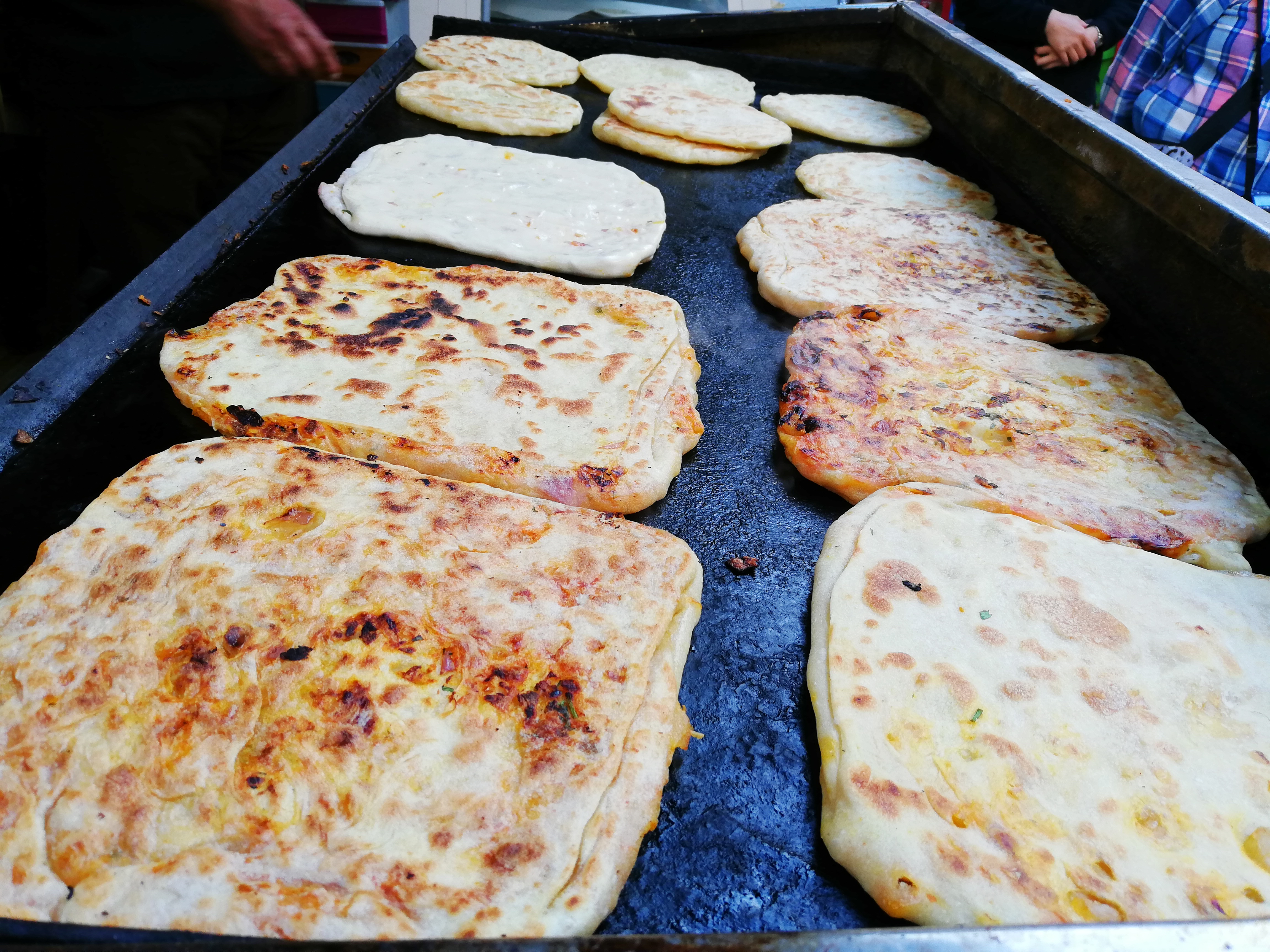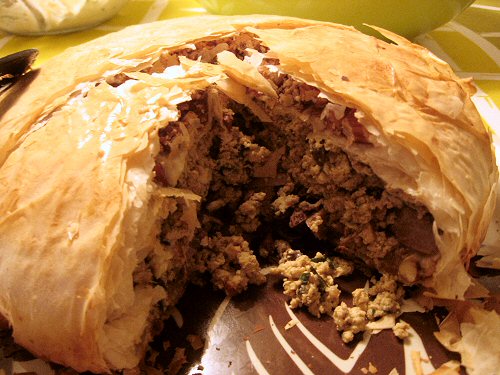|
Msemmen
M'semen, msemmen ( ar, مسمن ''msamman'', ''musamman'') or rghaif, is a traditional flatbread originally from the Maghreb, commonly found in Algeria, Morocco, and Tunisia. It is usually served with honey or a cup of aromatic morning mint tea or coffee. M'semen can also be stuffed with meat (khlea) or onion and tomatoes. Varieties and similar foods There is a variety that is made from pulling the dough into strands and forming a disk that is also called ''malwi'' in Northwest Africa. It is also similar to the Somali '' sabaayah.'' Recipe M'semen dough is made of flour, durum wheat semolina, dry yeast, melted butter, salt, sugar and a bit of water. The dough is cut into several balls, which are then rolled out on an oiled surface and folded into square pancakes with multiple internal layers. Semolina is sprinkled on the layers to prevent sticking and to allow for the heat to separate the layers when cooked on a griddle. See also * List of breads * Berber cuisine The Am ... [...More Info...] [...Related Items...] OR: [Wikipedia] [Google] [Baidu] |
Maghreb
The Maghreb (; ar, الْمَغْرِب, al-Maghrib, lit=the west), also known as the Arab Maghreb ( ar, المغرب العربي) and Northwest Africa, is the western part of North Africa and the Arab world. The region includes Algeria, Libya, Mauritania (also considered part of West Africa), Morocco, and Tunisia. The Maghreb also includes the disputed territory of Western Sahara (controlled mostly by Morocco and partly by the Sahrawi Arab Democratic Republic) and the Spanish cities Ceuta and Melilla.Article 143. As of 2018, the region had a population of over 100 million people. Through the 18th and 19th centuries, English sources often referred to the region as the Barbary Coast or the Barbary States, a term derived from the demonym of the Berbers. Sometimes, the region is referred to as the Land of the Atlas, referring to the Atlas Mountains, which are located within it. The Maghreb is usually defined as encompassing much of the northern part of Africa, including ... [...More Info...] [...Related Items...] OR: [Wikipedia] [Google] [Baidu] |
List Of Breads
This is a list of notable baked or steamed bread varieties. This list does not include cakes, pastries, or fried dough foods, which are listed in separate Wikipedia articles. It also does not list foods in which bread is an ''ingredient'' which is processed further before serving. Breads * See also * List of American breads * List of baked goods * List of brand name breads * List of bread dishes * List of bread rolls * List of British breads * List of French breads * List of Indian breads * List of Pakistani breads * List of sourdough breads * List of buns * List of cakes * List of cookies * List of pancakes * List of pastries * List of pies, tarts and flans * List of puddings * List of quick breads * List of sandwiches * List of sweet breads * List of toast dishes Toast is sliced bread that has been browned by exposure to radiant heat. It appears as a main ingredient in many dishes, often as a base on which other food is served. Toast dishes * Avocado toast – m ... [...More Info...] [...Related Items...] OR: [Wikipedia] [Google] [Baidu] |
Flatbreads
A flatbread is a bread made with flour; water, milk, yogurt, or other liquid; and salt, and then thoroughly rolled into flattened dough. Many flatbreads are unleavened, although some are leavened, such as pizza and pita bread. Flatbreads range from below one millimeter to a few centimeters thick so that they can be easily eaten without being sliced. They can be baked in an oven, fried in hot oil, grilled over hot coals, cooked on a hot pan, tava, comal, or metal griddle, and eaten fresh or packaged and frozen for later use. History Flatbreads were amongst the earliest processed foods, and evidence of their production has been found at ancient sites in Mesopotamia, ancient Egypt, and the Indus civilization. In 2018, charred bread crumbs were found at a Natufian site called Shubayqa 1 in Jordan (in Harrat ash Shaam, the Black Desert) dating to 12,400 BC, some 4,000 years before the start of agriculture in the region. Analysis showed that they were probably from flatbread con ... [...More Info...] [...Related Items...] OR: [Wikipedia] [Google] [Baidu] |
North African Cuisine
Maghreb cuisine is the cooking of the Maghreb region, the northwesternmost part of Africa along the Mediterranean Sea, consisting of the countries of Algeria, Libya, Mauritania, Morocco, and Tunisia. Well-known dishes from the region include ''couscous'', ''pastilla'', and ''tajine'' stew. Origins The cuisine of the Maghreb, the western region of North Africa that includes Algeria, Morocco, Tunisia and Libya, as well as Mauritania, is by origin Berber. The cuisines of Algeria, Tunisia and Libya have also been influenced by French and Italian cuisine respectively. Cuisine In Maghrebi cuisine, the most common staple foods are wheat (for ''khobz'' bread and ''couscous''), fish, seafood, goat,"North African Cuisine." [...More Info...] [...Related Items...] OR: [Wikipedia] [Google] [Baidu] |
Moroccan Cuisine
Moroccan cuisine () is the cuisine of Morocco, fueled by interactions and exchanges with many cultures and nations over the centuries. Moroccan cuisine is usually a mix of Arab, Berber, Andalusi, and Mediterranean cuisines, with minimal European (French and Spanish) and sub-Saharan influences. Like the rest of the Maghrebi cuisine, Moroccan cuisine has more in common with Middle Eastern cuisine than with the rest of Africa. According to Moroccan chef and cuisine researcher Hossin Houari, the oldest traces of Moroccan cuisine that can still be observed today, go back to the 7th century BC. Ingredients Morocco produces a large range of Mediterranean fruits and vegetables, as well as tropical products like snails. Common meats include beef, goat, mutton and lamb, which, together with chicken and seafood, serve as a base for the cuisine. Characteristic flavorings include lemon pickle, argan oil, preserved butter ( smen), olive oil, and dried fruits. The staple grains today ar ... [...More Info...] [...Related Items...] OR: [Wikipedia] [Google] [Baidu] |
Algerian Cuisine
The cuisine of Algeria is influenced by Algeria's interactions and exchanges with other cultures and nations over the centuries. It is characterized by a wealth derived from both land and sea products. Conquests or demographic movement towards the Algerian territory were two of the main factors of exchanges between the different peoples and cultures (Berbers, Arabs, Turks, Andalusians, French, and Spaniards). This cuisine is a Mediterranean and North African cuisine with Berber roots. Algerian cuisine offers a variety of dishes depending on the region and the season, but vegetables and cereals remain at its core. Most of the Algerian dishes are centered around bread, meats (lamb, beef or poultry), olive oil, vegetables, and fresh herbs. Vegetables are often used for salads, soups, tajines, couscous, and sauce-based dishes. Of all the Algerian traditional dishes available, the most famous one is couscous, recognized as a national dish. Ingredients Algeria, like other Maghreb c ... [...More Info...] [...Related Items...] OR: [Wikipedia] [Google] [Baidu] |
Arab Cuisine
Arab cuisine ( ar, المطبخ العربي) is the cuisine of the Arabs, defined as the various regional cuisines spanning the Arab world, from the Maghreb to the Fertile Crescent and the Arabian Peninsula. These cuisines are centuries old and reflect the culture of trading in baharat (spices), herbs, and foods. The regions have many similarities, but also unique traditions. They have also been influenced by climate, cultivation, and mutual commerce. Medieval cuisine Breads The white bread was made with high-quality wheat flour, similar to bread but thicker, the fermented dough was leavened usually with yeast and "baker's borax" () and baked in a '' tandoor''. One poetic verse describing this bread: "In the farthest end of Karkh of Baghdad, a baker I saw offering bread, splendidly marvelous. From purest essence of wheat contrived. Radiant and absolute, you may see your image reflected, crystal clear. rounds glowing with lovely whiteness, more playful than gorgeous singin ... [...More Info...] [...Related Items...] OR: [Wikipedia] [Google] [Baidu] |
Berber Culture
, image = File:Berber_flag.svg , caption = The Berber ethnic flag , population = 36 million , region1 = Morocco , pop1 = 14 million to 18 million , region2 = Algeria , pop2 = 9 million to ~13 million , region3 = Mauritania , pop3 = 2.9 million , region4 = Niger , pop4 = 2.6 million, Niger: 11% of 23.6 million , region5 = France , pop5 = 2 million , region6 = Mali , pop6 = 850,000 , region7 = Libya , pop7 = 600,000 , region8 = Belgium , pop8 = 500,000 (including descendants) , region9 = Netherlands , pop9 = 467,455 (including descendants) , region10 = Burkina Faso , pop10 = 406,271, Burkina Faso: 1.9% of 21.4 million , region11 = Egypt , pop11 = 23,000 or 1,826,580 , region12 = Tunisia , pop12 ... [...More Info...] [...Related Items...] OR: [Wikipedia] [Google] [Baidu] |
Berber Cuisine
The Amazigh (Berber) cuisine is a traditional cuisine with a varied history and influence of numerous flavours from distinct regions across North Africa. The traditional cuisine draws influences from Morocco's Atlas mountains and heavily populated Berber cities and regions, as well as Algeria's Berber cities and regions. Berber cuisine differs from one area to another within North Africa and West Africa(Mauritania). For this reason, every dish has a distinct and unique identity according to the specific region it originates from in North Africa, with some dishes estimated to be more than a thousand years old. Zayanes of the region of Khénifra around the Middle Atlas have a cuisine of a remarkable simplicity. It is based primarily on corn, barley, ewe's milk, goat cheese, butter, honey, meat, and game. Popular authentic Berber preparations of Tunisian, Moroccan, Algerian, and Libyan, Mauritanian cuisine include tajine, couscous, shakshouka, pastilla, msemen, merguez, asida, l ... [...More Info...] [...Related Items...] OR: [Wikipedia] [Google] [Baidu] |
Durum Wheat
Durum wheat (), also called pasta wheat or macaroni wheat (''Triticum durum'' or ''Triticum turgidum'' subsp. ''durum''), is a Polyploid, tetraploid species of wheat. It is the second most cultivated species of wheat after common wheat, although it represents only 5% to 8% of global wheat production. It was developed by artificial selection of the domesticated emmer wheat strains formerly grown in Central Europe and the Near East around 7000 BC, which developed a naked, Wheat#Hulled versus free-threshing species, free-threshing form. Like emmer, durum wheat is Awn (botany), awned (with bristles). It is the predominant wheat that grows in the Middle East. ''Durum'' in Latin means "hard", and the species is the hardest of all wheats. This refers to the resistance of the grain to milling, in particular of the starchy endosperm, implying dough made from its flour is weak or "soft". This makes durum favorable for semolina and pasta and less practical for flour, which requires more wor ... [...More Info...] [...Related Items...] OR: [Wikipedia] [Google] [Baidu] |
Mhadjeb
Mahdjouba (Arabic: محجوبة) or Mhadjeb is a crepe-like semolina based flatbread originating from Algeria. Mhadjeb is a traditional Algerian dish, it is a fine crepe-like semolina based flatbread typically stuffed with a mixture of onion, garlic, tomato, peppers and spices. It is very popular in all the regions of Algeria, including the southern regions such as Ouargla, Ghardaia, and Tamanrasset. It is one of the essential dishes offered in Algerian street foods. The mahdjouba, which means "covered" or "veiled" in Algerian Darja, originates from southern Algeria Biskra, Touggourt. It is the vegetable filled variation of M'semen, a traditional North African flatbread. See also * Algerian cuisine The cuisine of Algeria is influenced by Algeria's interactions and exchanges with other cultures and nations over the centuries. It is characterized by a wealth derived from both land and sea products. Conquests or demographic movement towards ... References Algerian cuisin ... [...More Info...] [...Related Items...] OR: [Wikipedia] [Google] [Baidu] |





